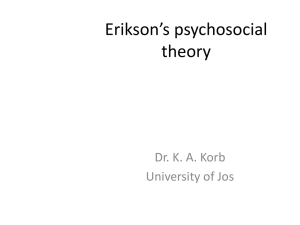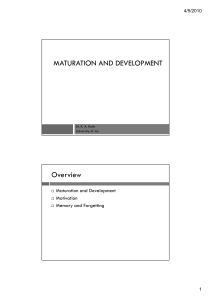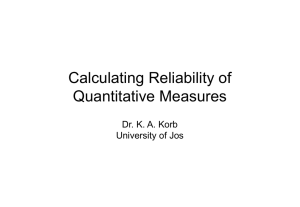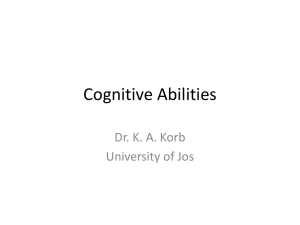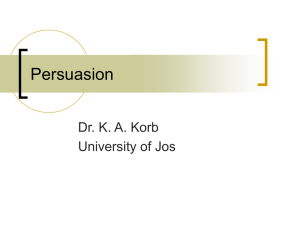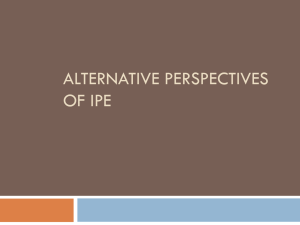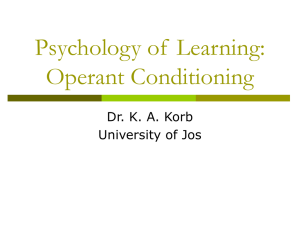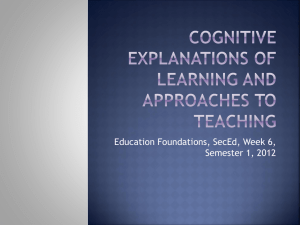Constructivism - Educational Psychology
advertisement
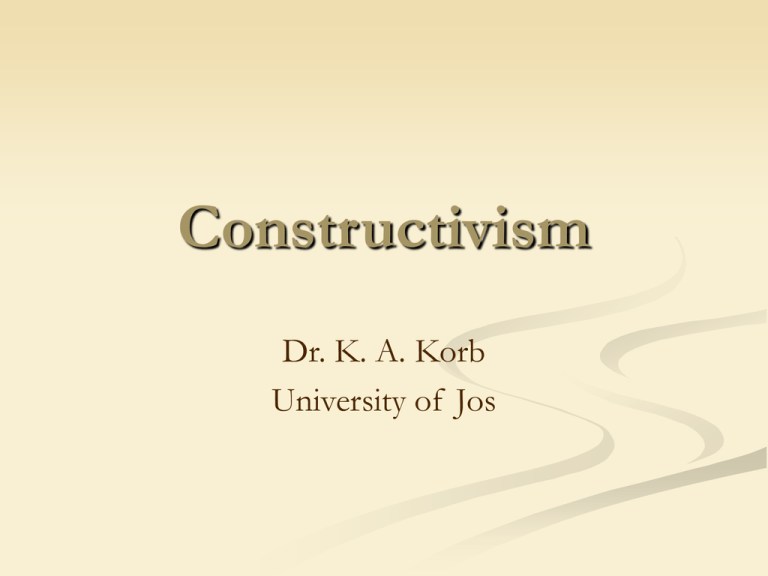
Constructivism Dr. K. A. Korb University of Jos Outline Overview of Constructivism Two Types of Constructivism Learning according to Constructivism Constructivist Teaching Strategies Dr. K. A. Korb University of Jos Constructivism Learners construct their own meaning from information in the environment Behaviorism Passive Dr. K. A. Korb University of Jos Cognitive Theories Actively process incoming information Constructivism Actively seek to understand the environment Assumptions of Constructivism Knowledge is constructed as learners make sense of their experience Knowledge constructions may not match reality Learners actively seek meaning in the environment In the learning process, learners create and test theories until a satisfactory explanation is known Knowledge is context-dependent Social interactions are vital to learning Dr. K. A. Korb University of Jos Constructivism: Process of Learning Schema: Typically a misconception Test Schema Develop new schema (Accommodate) No Expected Results? Dr. K. A. Korb University of Jos Yes Assimilate Discovery Learning Kobo Large bag of Rice Large Block of Wood Orange Metal Knife Dr. K. A. Korb University of Jos Balloon Types of Constructivism Psychological Constructivism: Learning as improving individual knowledge and cognitive abilities Many cognitive theories of learning can also be classified as Psychological Constructivist theories Radical Constructivism: There is no truth in the world, only individual’s perceptions of the world Dr. K. A. Korb University of Jos Constructivism Schema: Mental representation of the world Dr. K. A. Korb University of Jos Constructivism Equilibrium Dr. K. A. Korb University of Jos Balance between world and mind Occurs when schema works to explain world Constructivism Disequilibrium Dr. K. A. Korb University of Jos Disconnect between world and mind Occurs when schema cannot explain the world Uncomfortable Constructivism Assimilation: Fit new information (world) into existing schema (mind) Interpret world in terms of mind Dr. K. A. Korb University of Jos Accommodation: Change schema (mind) to explain new situation (world) Mind is changed because of the world Constructivism Schema World Type Addition Subtraction is the opposite of addition Assimilation Flat Earth Round Earth Accommodation Four legs = dog Animal has four legs. Calls a goat a dog Assimilation Adjust denominator Accommodation Adding factions: Add top keep bottom same Dr. K. A. Korb University of Jos Types of Constructivism Social Constructivism: Learning as increasing the ability to participate with others in activities meaningful within the culture Culture influences thinking when a more skilled person uses tools and practices from the culture to instruct another toward valued cultural goals Thinking influences culture when members generate new practices and solutions to add to the cultural group’s repertoire Dr. K. A. Korb University of Jos Learning in Context Education should focus on teaching knowledge that will be useful for life-long learning Learning Goals Ability to solve problems Critical thinking skills Personal inquiry skills Dr. K. A. Korb University of Jos Ability to identify and pursue own learning goals A general wishes to capture a fortress located in the center of a country. There are many reads radiating outward from the fortress. All have been mined so that while small groups of men can pass over the roads safely, a large force will detonate the mines. A full-scale direct attack is therefore impossible. The general's solution is to divide his army into small groups, send each group to the head of a different road, and have the groups converge simultaneously on the fortress. Dr. K. A. Korb University of Jos The next passage is conceptually similar to the previous passage. Use the solution from the previous slide to solve the next problem. Dr. K. A. Korb University of Jos You are a doctor faced with a patient who has a malignant tumor in his stomach. It is impossible to operate on the patient, but unless the tumor is destroyed the patient will die. There is a kind of ray that may be used to destroy the tumor. If the rays reach the tumor all at once and with sufficiently high intensity, the tumor will be destroyed, but surrounding tissue may be damaged as well. At lower intensities the rays are harmless to healthy tissue, but they will not affect the tumor either. What type of procedure might be used to destroy the tumor with the rays, and at the same time avoid destroying the healthy tissue? Dr. K. A. Korb University of Jos Transfer Transfer: Effect of previous learning on new learning. Factors that affect transfer: Similarity of learning situations Depth of original understanding Quality of learning experiences Context for learning Variety of experiences Emphasis on metacognition Dr. K. A. Korb University of Jos Situated Learning Situated Learning: Skills and knowledge are tied to the situation where they were learned Knowledge learned outside of a meaningful context is useless Focus on apprenticeships Dr. K. A. Korb University of Jos Expert guides novice beginning with simple and increasing to complex Conditions of Learning Learning occurs in complex, realistic, and relevant environments Social interaction is an important aspect of learning Teach with multiple modes of representation Foster ownership in learning Teach metacognitive skills Dr. K. A. Korb University of Jos Constructivist Teaching Goal of Teaching: Identify the skills or information that the learner needs to know prior to problem solving Learners more motivated to learn when faced with problem solving situation that requires a bit of new information Prerequisite skills are focused on in the context of higher-order goals Dr. K. A. Korb University of Jos Problem-Based Learning Real World Problem Collaborate to find solution Teacher’s Role Dr. K. A. Korb University of Jos Provide topic, Gather background information, Create ways to incorporate a variety of subjects, Delegate tasks to students, Facilitate the project Instructional Conversations Conversations with probing questions to facilitate deep learning Teachers scaffold (Vygotsky) Teacher’s Role Dr. K. A. Korb University of Jos Facilitate the discussion, Use good questioning techniques, Be open to student input Cognitive Apprenticeships Students work with an expert Real-life situation Expert’s Role Dr. K. A. Korb University of Jos Model, Guide, Scaffold Inquiry Learning Process Dr. K. A. Korb University of Jos Hypothesize Test Report Evaluate Inquiry Learning Scientific Procedure Hypothesis Test Hypothesis Draw Conclusions Reflect First-hand vs. Second-hand Investigations Teacher’s Role Dr. K. A. Korb University of Jos Identify topic of study, Pose deep questions, Provide appropriate materials, Guide, Let students ask questions and discover the answer Constructivism Common elements of all constructivist teaching strategies Students actively participate Teacher is a facilitator Requires deep thinking from students Real-world applications Social orientation Dr. K. A. Korb University of Jos Applying Constructivism to Instruction Elicit students’ ideas and experiences, then create learning situations to restructure current knowledge Provide opportunities to engage in complex, meaningful, problem-based activities Provide opportunities for students to apply the knowledge in many meaningful contexts Teach self-regulation strategies Dr. K. A. Korb University of Jos Constructivism Strengths: Learning is interesting Learning is relevant Students are active in classroom Deep learning Creativity from the students Motivated to learn Dr. K. A. Korb University of Jos Constructivism Weaknesses Hard to plan for Students may ask questions you don’t know the answer to Difficult for low students Takes lots of classroom time Not cover as much material Dr. K. A. Korb University of Jos Research-Supported Conclusions Active learners are most successful Learning from examples and doing fosters deep understanding Meaningful learning is most effective as compared to rote learning The social structure of the learning environment is critical to successful learning Dr. K. A. Korb University of Jos Constructivist Theories Overview Results: Meaning of the environment Means: Attempt to develop a theory of the world Inputs: New information from the environment Dr. K. A. Korb University of Jos Constructivist Theories Overview Learning Outcomes: Reasoning, Critical Thinking Role of the Learner: Make meaning of the world Role of the Instructor: Provide complex and realistic learning environments that challenge learners to solve problems Inputs for Learning: Self-regulation learning skills, Motivation to make sense of the environment Process of Learning: Assimilation and Accommodation Dr. K. A. Korb University of Jos Weakness of constructivism Revision What are the assumptions of a constructivist view of learning? What are the two types of constructivism? What is the difference between assimilation and accommodation? What are a few constructivist teaching strategies? Dr. K. A. Korb University of Jos
